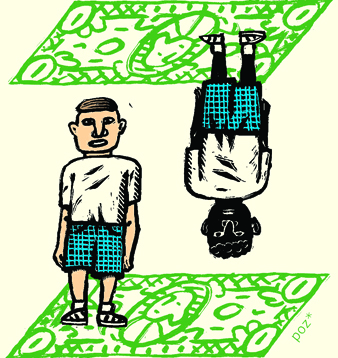 PETER O. ZIERLEIN
PETER O. ZIERLEIN
The current presidential campaign has sparked a lot of conversation about race, but it has primarily been at the symbolic and interpersonal level. It has failed to probe the underlying substance of racial economic disparities and the slow rate of progress toward equity in wealth and wages. Too many Americans naïvely see the strong presidential candidacy of Illinois Senator Barack Obama as evidence of the resolution of the racial divide.
Since 1968, the year Martin Luther King Jr. was assassinated, the income gap between blacks and whites has narrowed by just three cents on the dollar. In 2005 the median per capita income in the United States stood at $16,629 for blacks and $28,946 for whites. At this slow rate of progress, we will not achieve income equality for 537 years. And if politicians continue to dismantle government checks on income and wealth concentration, even these modest gains may be reversed.
Extreme inequality in the overall economy exacerbates income and wealth disparities between whites and people of color. These disparities remain shockingly wide and especially evident when we examine the polarization of assets and wealth in the United States. The black homeownership rate, for instance, sits at 47 percent and the Latino rate at 49.7 percent, compared with 75 percent for whites.
African-American families in the United States have a median net worth of $20,600, only 14.6 percent of the $140,700 median white net worth. The median net worth for Latino families is $18,600, only 13.2 percent of median white net worth. Between 1983 and 2004, the most recent year for which official federal data are available, median black and Latino wealth inched up from 7 percent to 10 percent of median white wealth. At this rate, we will not achieve wealth equality for 634 years.
Even more disturbing, the tiny wealth gains of recent decades are evaporating as the subprime mortgage meltdown continues to spread. According to Home Mortgage Disclosure Act data, blacks are three times as likely as whites to have received a subprime loan and four times as likely to have refinanced from a subprime lender. Figures for Latinos are just as depressing. According to the Center for Responsible Lending, Latinos will lose between $75 billion and $98 billion in home-value wealth from subprime loans. Blacks will lose between $71 billion and $92 billion. United for a Fair Economy has called this family net-worth catastrophe the “greatest loss of wealth for people of color in modern U.S. history.”
The subprime fiasco is rippling through communities of color like miniature Hurricane Katrinas. And we are witnessing only the beginning of the impact: foreclosure, displacement, family upheaval, the devaluation of entire neighborhoods, eroding local tax bases, the decline of local services.
Our nation needs to make a dramatic reinvestment in broadening wealth and opportunity–for all Americans. In the decades after FDR’s New Deal, such investments–including low-interest home-buyer loans, grants for college education and small-business subsidies–helped tens of millions of families enter the middle class. But these wealth-building programs directly or indirectly excluded people of color. They thus bolstered the economic supremacy of whites, continuing the American legacy of racist inequality.
Since the end of legal segregation and discrimination, we have not seen comparable government investment programs that could benefit people of color. We urgently need such programs, including matching savings plans to build assets and purchase homes. We can afford them–but only if we stop investing America’s resources in the wealthiest people, leaving the rest of Americans to survive on a trickle.


